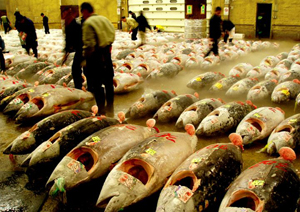
Lloyd Spencer Davis
OPINION: NOUMEA, New Caledonia (Otago Daily Times / Pacific Media Watch): I have been in Noumea less than 24 hours when I am struck by a thought: tuna are the sheep of the sea.
Not in the sense of what they look like, what they eat, or their role in the ecosystem. No, it is their economic importance to Pacific island nations that mirrors what sheep farming is to New Zealand.
For New Caledonia, Niue, Fiji, Tonga, Samoa, the Solomons, the Marshalls, Kiribati, Papua New Guinea and a dozen other South Pacific island states, selling licences to fish for tuna within their economic zones has become a major source of their income; in many cases, the major source of their income. But there are two looming problems that threaten the future of this cash cow, or rather, fish.
So dramatic has been the rise in tuna fishing in the South Pacific - mainly by Asian countries such as Japan, Taiwan, China and South Korea - the long-term viability of the fish stocks may be in jeopardy.
The second problem is more insidious and even harder to assess: tuna are open-ocean fish, going where the currents and upwellings of nutrients dictate their food supplies will be, and, as such, they are at the mercy of the changes to ocean patterns wrought by global warming and increasing sea-surface temperatures.
The Secretariat of the Pacific Community (SPC), headquartered in Noumea, is charged with monitoring these problems and advising its member countries what, if anything, can be done about them.
Dr Shelton Harley is its head of stock assessment and modelling: with close-cropped hair, a few days' stubble and a predilection for Hawai'ian shirts, he looks more like one of the windsurfers from across the road than the stereotypical desk jockey such a title would suggest.
No-nonsense bluntness
Contrasting with the casualness of his dress, there is a no-nonsense bluntness to Dr Harley.
"Tuna are an incredibly diverse group of species," he says by way of an opening salvo.
It clearly irritates him that the news media and special-interest groups often lump all tuna under the same net, so to speak, when the threats are completely different for a small tuna species such as the rapidly reproducing skipjack tuna versus the large bluefin and bigeye tuna that are slow-growing, slow-maturing and slow to replace depleted stocks.
Another issue is the price that different species command.
"The more valuable a species is," he says, "the easier it is to keep fishing that population until it gets lower and lower and lower."
Last month, a 269kg Pacific bluefin tuna sold for a record $NZ937,300 - or $3484 per kilogram - at Tokyo's Tsukiji fish market: incentive enough to keep fishing even if the cost of doing so goes up and the volume goes down.
Dr Harley's colleague in the Oceanic Fisheries Group of SPC, Dr Graham Pilling, shares the same haircut but is clean-shaven and, whereas Dr Harley wears his brashness on his gaudy sleeves, Dr Pilling is as softly spoken as his dress is subdued.
He works on all four species of tuna that SPC monitors: skipjack, yellowfin, albacore and bigeye.
"In general, the [tuna] stocks are doing OK. The only stock where we have a current concern is bigeye tuna, where there's basically too many boats out there catching tuna." He and other SPC scientists are recommending a 33% reduction in fishing effort "to reduce the impact on bigeye tuna".
A year earlier, I had gone to Tokyo's Tsukiji market before dawn to watch men in gumboots haggle over prices, while at their feet on wet concrete floors lay the frozen carcasses of bigeye and other tuna caught on longlines at great depths from places far away in the Pacific.
Frozen bodies
Their frozen bodies, humanlike in their dimensions and weight, were laid out in rows reminiscent of images I had seen on television of an Iraqi mortuary: the analogy to war easy to acquire, especially when security men bundled me out of there as if they had something to hide.
Dr Johann Bell, principal fisheries scientist with SPC, tells me it is important to distinguish between two types of tuna fishery: the surface fishery that uses purse seine nets and catches the small species such as skipjack used largely for canned tuna, and the deep-water fishery, using longlines, which targets the larger species such as bigeye that grace the floors of Tsukiji.
Last year, 2.4 million tonnes of tuna were caught in the Western and Central Pacific region, accounting for 83% of the tuna caught in the Pacific and 60 percent worldwide. Of that, the vast majority - 1.75 million tonnes - was skipjack tuna, and that fishery has just been awarded Marine Stewardship Council certification, making it easily the world's largest sustainably managed fishery.
Furthermore, the skipjack fishery is hardly a poster child for campaigns that suggest an Asian invasion is pillaging the Pacific's tuna. Papua New Guinea and the Solomon Islands, in particular, have been setting up canneries for skipjack tuna on their own soil rather than having the fish that is caught within their economic zones taken back to canneries in Asia. This is a critically important development given that by 2035, the populations in this region - which encompasses Melanesia, Micronesia and Polynesia - are set to increase by 50% while at the same time overfishing and global warming are predicted to reduce catches of the coastal reef fishes upon which so many of these Pacific communities depend.
According to Dr Bell, "The region is actually very fortunate, blessed if you like, because they have an abundant resource of tuna, and we need to use more of that tuna for feeding people locally rather than just looking at it as a source of income or economic returns."
Like the reef fish, however, tuna will also be affected by global warming, the modelling suggesting the distributions of skipjack, bigeye and other tuna will eventually move eastwards.
It should be a boon for the likes of Kiribati, now on the eastern edge of the fishery, but potentially devastating for the two biggest local players in the west: Papua New Guinea and the Solomons.
Clear advice
Dr Bell's advice is clear: "[They] need to put plans in place so they can continue to receive tuna for their canneries."
On my last night in Noumea, I go with Dr Bell and a few others to Au P'tit Cafe, supposedly the finest restaurant in Noumea. We eat outside on a deck that is all chrome, wood and fancy lights and which could have been anywhere in the swankier parts of Auckland. One of my dishes contains a slab of dark-red raw fish. I ask Dr Bell what it is. He looks across the table, "Oh, you're lucky, it's bigeye."
I take a bite intent on describing the taste. It proves impossible. The flesh is soft and simply dissolves in my mouth, as tantalising and as ephemeral as the fleeting whiff of the waitress' perfume.
Suddenly, I see the irony in how such a big fish - typically the same length as me at 180cm but considerably sturdier at up to 200kg or more - could be made so vulnerable: it is because their flesh is so delicate.
Until the fisheries for bigeye, bluefin, and other large tuna caught on longlines are brought to within sustainable limits, I reckon we would be best to eat canned skipjack tuna instead, comfortable in the knowledge it is not so much being pillaged as farmed.
This is the second of two articles prepared after Professor Lloyd Spencer Davis of Otago University attended a recent forum on communication for scientists of the Secretariat of the Pacific Community in Noumea, New Caledonia.

This work is licensed under a Creative Commons Attribution-NonCommercial 3.0 New Zealand Licence.



